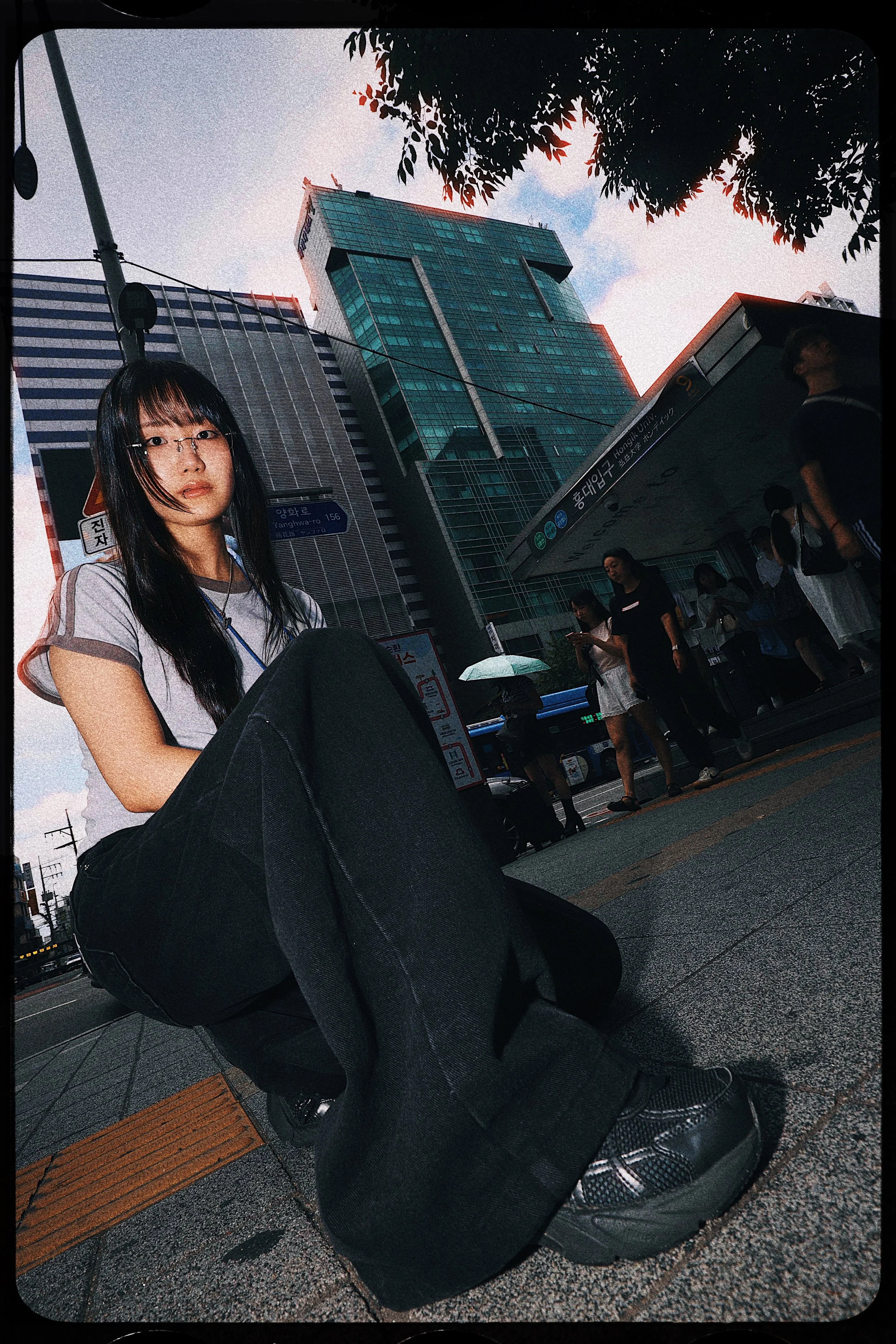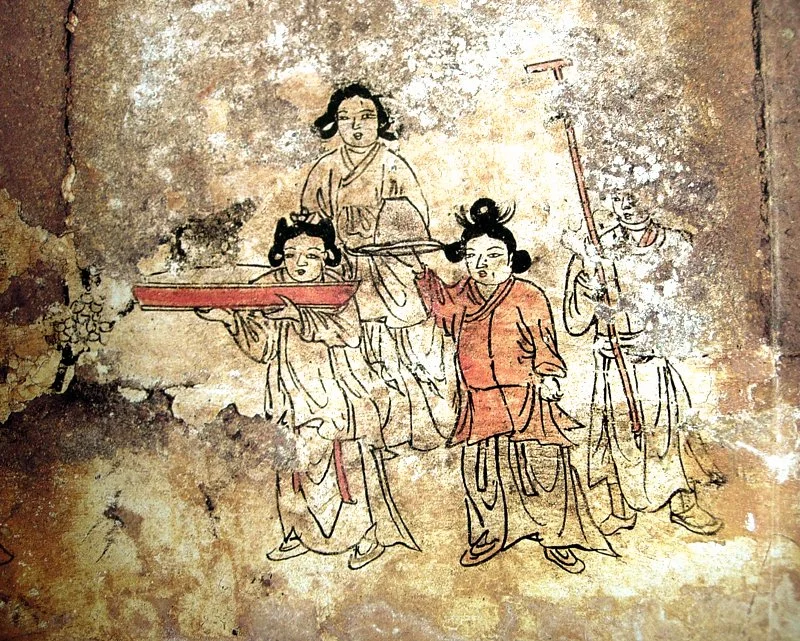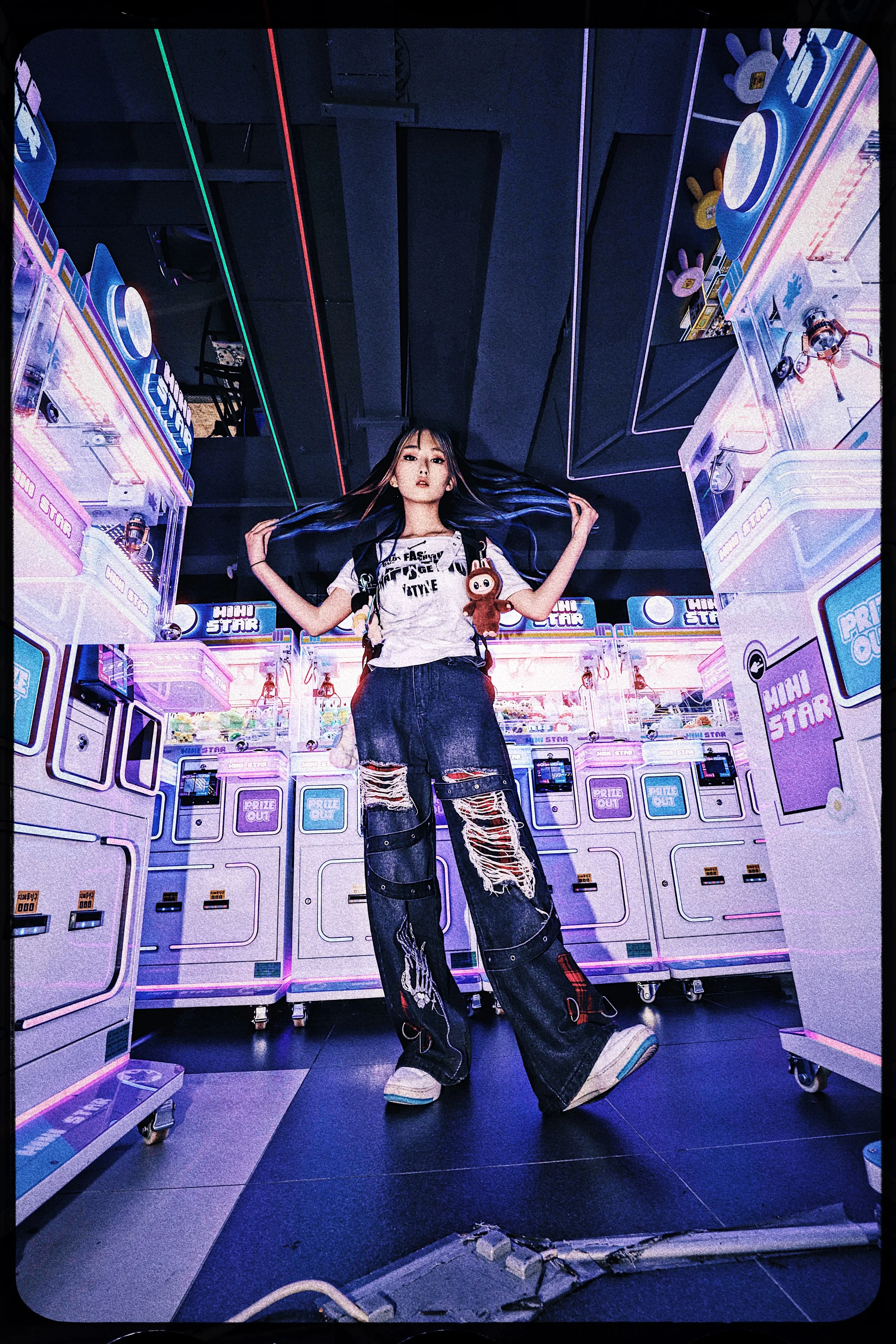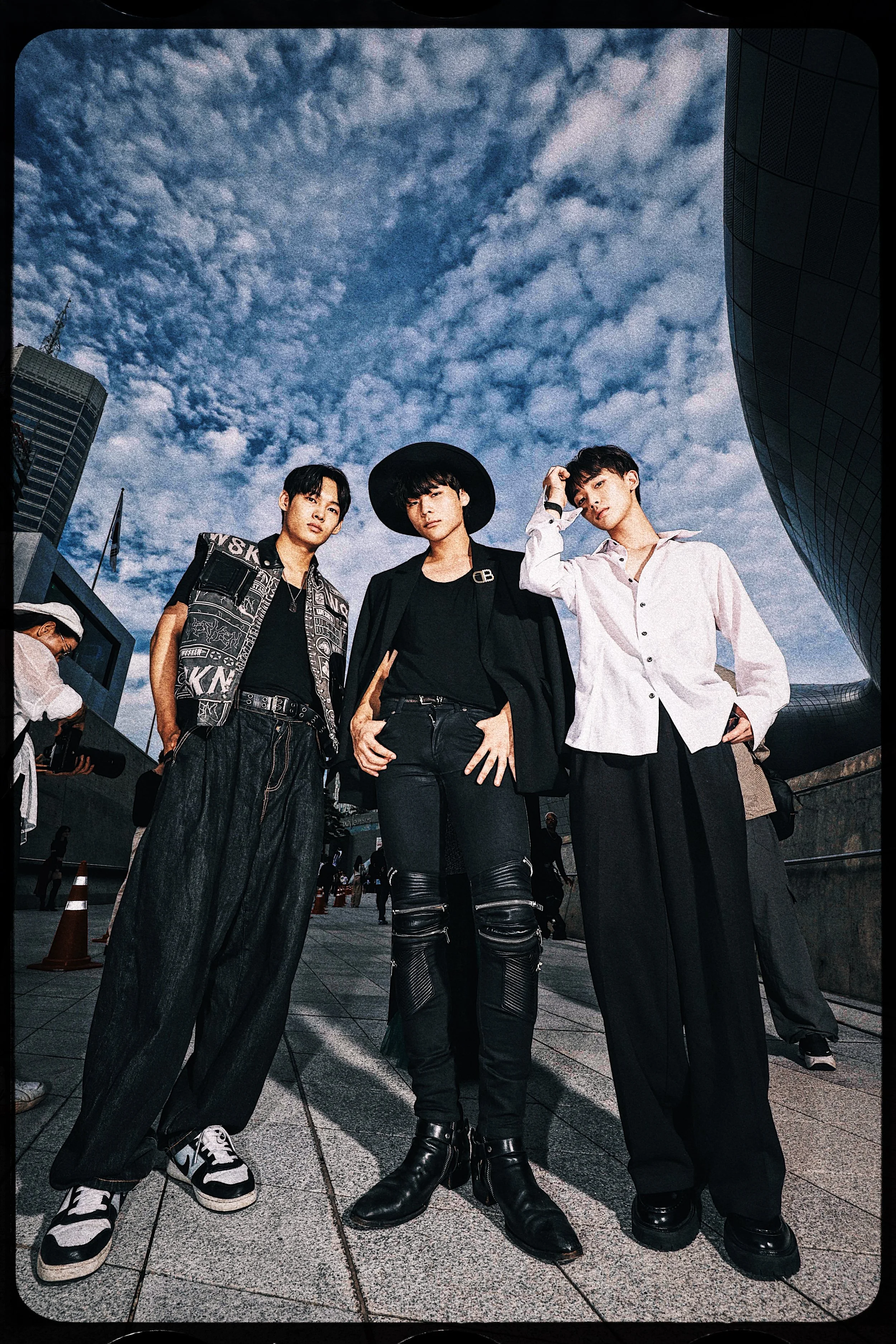Drowning in Fabric: How Korea's Overfit Obsession Cracked the Code of Cultural Identity
A university student poses in her overfit, baggy jeans at Hongdae Station in July, 2025. She noted that the jeans bottoms needed to be frayed to be considered cool.
Picture a young woman walking through Seoul's Hongdae district on a Thursday afternoon. She's wearing jeans that could fit two of her inside. Her oversized sweater hangs off her bones like a tent. Her sneakers peek out from beneath fabric pooling around her ankles. The bottom of her baggy pants are filthy and frayed. To an outside observer, she looks like she's borrowed her slovenly older brother's entire wardrobe.
She's not making a fashion mistake. She's making a statement.
This is the story of “overfit” — Korea's most counterintuitive fashion trend that reveals something profound about how cultures adapt, resist, and evolve. You might think fashion is about showing off your body. In Korea's overfit revolution, the opposite proved true: hiding your shape became the ultimate expression of finding yourself.
When the Cultural logic breaks down
Model/fashionista @sio.0.show reminds us that traditional, highly gendered trend looks tend to require more bodily exposure, which in turn requires more body self-regulation that causes stress and social pressure.
Here's what doesn't make sense about Korean overfit fashion. Korea has some of the world's most stringent beauty standards (Seo et al., 2020). Korean society prizes conformity and social harmony above individual expression (Cultural Atlas, 2023). The country's fashion industry generates billions by selling form-fitting, body-conscious clothing to global markets (Samsung Fashion Research Institute, 2024).
So why did Korean youth suddenly embrace clothing that obscures their bodies, challenges traditional beauty norms, and appears to reject everything their fashion industry stands for?
The answer lies in what sociologists call "the conformity paradox." Sometimes the most rebellious thing you can do in a conformist society is to conform — but to different rules.
Overfit represents Korean youth's sophisticated solution to an impossible cultural equation: how to express individuality while maintaining social belonging, challenge beauty standards while avoiding social exile, and embrace global trends while preserving Korean identity.
Let me give you the analytical framework to understand how this works. Think of fashion as operating on three levels simultaneously: the practical (what clothes do for your body), the social (what clothes communicate about your place in society), and the psychological (what clothes do for your sense of self). Most fashion trends excel at one level. Overfit succeeds at all three.
The archaeology of baggy clothes
“Mural tomb of Bak Ik in Gobeop-ri, Miryang. Bak Ik was a civil official who lived from 1332 to 1398 CE, Early Joseon.” [SOURCE]
Before we solve the overfit mystery, we need to travel back seven centuries. In 1332, a man named Bak Ik died in Korea (Producer-muffet, 2024). When archaeologists opened his tomb in the 20th century, they discovered something unexpected. His clothes were baggy. Loose. Comfortable.
This wasn't unusual clothing for its time. For over 700 years, Korean traditional dress featured what fashion historians describe as "naturally flowing garments without artificial beauty" (Encyclopedia.com, 2024). The hanbok's loose silhouettes, roomy sleeves, and comfortable proportions became foundational elements of Korean aesthetic philosophy.
Here's the key insight: overfit isn't a foreign trend that Korea adopted. It's a traditional Korean approach to clothing that Korea rediscovered.
Fashion scholars have identified a pattern in Korean dress history. During periods of cultural uncertainty—post-war recovery in the 1950s, democratization in the 1980s, economic crisis in the 1990s—Korean fashion returns to loose-fitting silhouettes (Creatrip, 2024). The current overfit trend represents the latest iteration of this cyclical pattern, triggered by contemporary identity challenges.
But why loose clothing during identity crises? The answer reveals something fundamental about how humans use fabric to navigate social turbulence.
When hiding became showing off
Model @kx.m09 shows her true colors in a gacha/claw machine arcade in the geondae neighborhood of Seoul in August 2025.
Let's return to our young woman in Hongdae. Her oversized clothes aren't just covering her body—they're making an argument.
Korean beauty standards create what researchers call "acculturative labor"—the exhausting work of constantly modifying yourself to meet external expectations (Seo et al., 2020). Young Korean women report spending hours daily on appearance management, from skincare routines to body modification procedures to careful wardrobe curation designed to minimize physical "flaws."
Overfit clothing short-circuits this entire system. When your clothes don't reveal your body shape, you can't be judged by body standards. When loose fabric becomes the fashionable silhouette, covering up becomes the stylish choice.
Korean online fashion communities use revealing language to describe overfit's appeal. Users write about "hiding cute belly fat," "covering narrow shoulders," and transforming what could be seen as "concealment" into "style" (Brunch, 2024). This represents a sophisticated form of cultural resistance disguised as trend participation.
The psychological impact goes deeper. Fashion psychologists have identified clothing's role in what they call "embodied confidence"—how what you wear affects how you feel about occupying space in the world (Lee & Suh, 2025). Restrictive clothing creates constant body awareness. Loose clothing creates body neutrality.
For Korean youth navigating intense social pressures, overfit clothing provides psychological sanctuary. You can focus on other forms of self-expression—academics, relationships, creative pursuits—without constant attention to physical presentation.
The democracy of baggy jeans
Here's another counterintuitive element of the overfit story. Korea's luxury fashion market thrives on expensive, perfectly tailored clothing that displays wealth through precise fit and premium materials (Samsung Fashion Research Institute, 2024). Status traditionally comes from clothes that obviously cost a lot of money.
A street fashionista caught outside of Hongdae Station shows a more everyday example of the baggy fit.
Overfit fashion inverts this entire value system. The most fashionable choice becomes purposefully ill-fitting clothing that costs less and lasts longer. Oversized clothes work across multiple body shapes and sizes. They don't require expensive tailoring. They hide wear and tear better than fitted alternatives.
Korean cultural commentators note this trend's "democratic" qualities (Goover, 2025). Unlike traditional fashion hierarchies based on purchasing power, overfit style depends on knowledge rather than wealth. Success comes from understanding proportion, color coordination, and styling techniques—cultural capital that anyone can develop regardless of economic resources.
This democratization particularly appeals to Korea's MZ generation, who prioritize "authenticity" and "value" over traditional status markers (OpenAds, 2024). Overfit allows fashion participation without conspicuous consumption, aligning with younger Koreans' skepticism toward materialistic display.
The economic logic extends to practical considerations. Korean consumers increasingly value "cost-effectiveness" and "quality over brand recognition" (Samsung Fashion Research Institute, 2024). Oversized clothing offers superior durability, versatility, and longevity compared to trend-dependent fitted alternatives.
The uniform of gender rebels
Fashionista @chae._.coke shows the camera the beauty of baggy and the camo cool at Seoul Fashion Week in September 2025.
Perhaps the most radical aspect of Korea's overfit trend involves its impact on gender expression. Traditional Korean fashion maintains clear gender distinctions through silhouette, color, and styling choices (Lee & Suh, 2025). Men's clothing emphasizes broad shoulders and narrow waists. Women's clothing highlights curves and feminine proportions.
Overfit clothing makes gender ambiguous. When everyone wears loose, comfortable silhouettes, traditional masculine and feminine clothing markers disappear. The result is fashion that enables gender experimentation within socially acceptable boundaries.
Korean men's fashion research reveals significant changes in masculinity expression through clothing choices (Lee & Suh, 2025). Young Korean men increasingly embrace "gender-fluid styling" and reject traditional formal wear in favor of "casual and street trends." Overfit provides socially acceptable entry point for exploring non-traditional masculine presentation.
Three “Saja Boys” at Seoul Fashion Week in September 2025 show a variety of sartorial approaches to masculinity in hypermodern Korea.
For Korean women, overfit represents participation in what some call the "escape the corset" movement—rejection of restrictive beauty standards through fashion choices (NPR, 2019). The trend allows women to opt out of appearance-based judgment while maintaining fashionable status.
This gender flexibility reflects broader changes in Korean society. K-pop culture promotes androgynous beauty standards for both male and female performers (Yale News, 2023). Younger Koreans increasingly question rigid gender roles inherited from Confucian traditions. Overfit fashion provides practical tools for expressing these evolving attitudes through everyday dress choices.
The algorithm that loved loose clothes
To understand overfit's rapid spread, we need to examine Korea's unique digital culture ecosystem. Korean Generation Z spends an average of 2.5 hours daily consuming fashion content across multiple platforms, with 52.4% using Instagram for style inspiration (OpenAds, 2024).
Social media algorithms created perfect conditions for overfit trend amplification. Platform recommendation systems favor content that generates high engagement. Overfit styling content performs exceptionally well because it provides actionable advice for immediate implementation. Users can quickly adopt oversized clothing choices and create their own content, feeding the algorithmic cycle.
Korean fashion influencers developed sophisticated overfit styling techniques specifically adapted to Korean body types and cultural preferences (AJ Marketing, 2025). This localization process transformed global oversized trends into distinctly Korean fashion expression. YouTube provides detailed styling tutorials, Instagram documents street fashion variations, TikTok drives viral styling challenges.
The digital dimension creates new forms of social capital based on styling knowledge rather than economic resources (Fibre2Fashion, 2024). Overfit mastery depends on understanding proportion, color coordination, and styling techniques—skills that can be learned through social media consumption and practice.
This democratization of fashion knowledge aligns with Korean values around education and self-improvement. Learning to style overfit clothing becomes a form of cultural competency that demonstrates both fashion literacy and social awareness.
How Korea taught the world to dress badly (and brilliantly)
Here's the most surprising aspect of Korea's overfit trend: it positions Korea as a fashion leader rather than follower. Korean fashion communities explicitly claim cultural ownership of mainstream overfit adoption (Eomisae, 2024). Users write that "Korea definitely seems to have made overfit mainstream" while noting that "except for Korea and Japan, overfit doesn't seem to be this much of a mainstream trend elsewhere."
This cultural confidence reflects Korea's transformation from fashion importer to fashion exporter. The Korean Wave (Hallyu) extends beyond entertainment to include fashion influence, with global youth increasingly adopting Korean styling approaches (SpringerOpen, 2023). Overfit becomes a vehicle for expressing Korean cultural sophistication rather than mere derivative trend adoption.
The international dimension reveals overfit's role in Korean soft power projection. Korean fashion companies leverage overfit's global appeal to expand international markets while maintaining cultural authenticity (Invest Korea, 2024). The trend demonstrates Korea's ability to create culturally specific fashion that resonates internationally.
Academic research on Korean cultural influence notes fashion's importance in global cultural positioning (ResearchGate, 2023). Overfit represents Korean society's successful navigation of globalization — adapting international influences through distinctly Korean cultural filters to create innovative fashion expression.
The cultural code that clothes cracked
What does the overfit phenomenon reveal about cultural adaptation in the 21st century? The story demonstrates how societies successfully negotiate global influences while maintaining cultural identity.
Traditional cultural theories predicted globalization would create a homogeneous global culture. Korea's overfit trend suggests a different pattern, one of glocalization: societies actively adapt global trends through indigenous cultural logic to serve local needs. The result is fashion that appears international but functions according to distinctly Korean social and psychological requirements.
This adaptation process involves what anthropologists call "cultural synthesis" — combining external influences with internal values to create new forms of cultural expression (SpringerOpen, 2023). Korean overfit succeeds because it simultaneously addresses practical needs (comfort, affordability), social requirements (conformity, belonging), and individual desires (self-expression, gender flexibility).
The trend's multifunctionality explains its sustained popularity across different demographic groups and social contexts. Korean society uses fashion as laboratory for social experimentation, testing new gender norms, economic relationships, and cultural values through clothing choices that carry minimal social risk.
Model @ttiwimln at Seoul Fashion Week SS26 proves that Korean men turned maximalism into confident masculinity—his flowing white coat and layered pearls would read as costume elsewhere but register as sophisticated expression here.
The story that's still being written
Korean fashion research indicates overfit trends continue evolving rather than declining (Samsung Fashion Research Institute, 2024). The trend adapts to changing social conditions while maintaining core appeal across practical, social, and psychological dimensions.
Recent developments include professional workplace acceptance of relaxed dress codes, luxury fashion brands incorporating overfit elements into high-end collections, and international fashion weeks featuring Korean oversized design approaches (Samsung Fashion Research Institute, 2024). These changes suggest overfit's transformation from youth subculture to mainstream fashion philosophy.
For understanding contemporary Korean society, overfit represents a case study in successful cultural evolution—maintaining traditional values while adapting to contemporary challenges. The trend demonstrates Korean youth's sophisticated cultural competency in navigating global influences while preserving social cohesion and cultural identity.
The story of Korea's overfit revolution ultimately reveals fashion's power as both mirror and motor of social change. In Korean context, clothing becomes tool for cultural negotiation, identity formation, and social evolution, revealing fashion's profound sociological significance beyond aesthetic preference.
The mystery of the baggy clothes, it turns out, was never really about the clothes at all. It was about finding new ways to be Korean in a rapidly changing world.
FINITO
AI usage Attribution
This article was researched and composed with the assistance of Claude (Anthropic, 2025), an AI language model. The research process involved AI-powered web searches to locate Korean-language and English-language sources on the overfit fashion trend, with particular emphasis on Korean cultural perspectives and academic analysis. Claude was prompted to write in an engaging way, structured following "a Malcolm Gladwell narrative style," with AI assistance in doing the desk research about Korean fashion trends across both Korean and English sources, organizing the most recent data on the phenomenon, and crafting accessible prose from academic sources as well. All factual claims are supported by cited sources, and the analytical frameworks represent synthesis of existing scholarly research rather than AI-generated speculation. Human oversight guided the research direction, source selection, interpretive framework, and final editorial decisions.
Distinguishing AI assistance from AI authorship: Current scholarly consensus holds that AI tools cannot be listed as authors because they "cannot take responsibility for the content and integrity of scientific work" (International Committee of Medical Journal Editors, 2023). Instead, AI serves as a tool requiring continuous human direction. This article exemplifies appropriate AI usage through iterative prompting—the AI could not have autonomously produced this analysis without specific instructions regarding research focus (Korean-language sources prioritization), analytical framework (sociological fashion analysis), structural approach (Gladwell narrative methodology), and multiple rounds of revision based on human editorial judgment. The process involved approximately 30+ distinct prompts directing research queries, requesting source verification, refining arguments, and adjusting tone and structure. As Nature's editorial policy states, "AI tools cannot be authors," but researchers bear full responsibility for any work produced with AI assistance (Nature, 2023). This distinction matters: autonomous AI generation represents plagiarism or academic dishonesty, while AI-assisted research with transparent disclosure represents legitimate scholarly tool usage (Council of Science Editors, 2024).
Note on evolving standards: As of 2025, standards for AI attribution in academic and journalistic writing remain in active development. Major style guides including APA, MLA, and Chicago have begun incorporating AI citation guidelines, though consensus on best practices continues to evolve (American Psychological Association, 2024; McAdoo, 2023). This attribution follows emerging transparency principles that emphasize disclosure of AI's specific roles in research and composition while acknowledging human intellectual responsibility (International Committee of Medical Journal Editors, 2023; Nature, 2023). The field recognizes that "AI assistance" encompasses a spectrum of activities—from basic grammar checking to substantive research synthesis—requiring nuanced disclosure rather than binary categorization (Council of Science Editors, 2024).
References
AJ Marketing. (2025). 2025년 국내 패션 유튜버 TOP 11 [Top 11 domestic fashion YouTubers in 2025]. https://www.ajmarketing.io/ko/feed/국내-패션-유튜버-top-11
American Psychological Association. (2024). How to cite ChatGPT. APA Style Blog. https://apastyle.apa.org/blog/how-to-cite-chatgpt
Anthropic. (2025). Claude (Version 4) [Large language model]. https://www.anthropic.com
Brunch. (2024). 사람들은 왜 오버핏을 입을까? [Why do people wear overfit?]. https://brunch.co.kr/@jms0350/4
Council of Science Editors. (2024). CSE's evolving guidance on generative AI in scholarly publishing. https://www.councilscienceeditors.org/resource-library/editorial-policies/cses-evolving-guidance-on-generative-ai-in-scholarly-publishing/
Creatrip. (2024). Korean fashion through the ages. https://creatrip.com/en/news/11973
Cultural Atlas. (2023). South Korean - Core concepts. https://culturalatlas.sbs.com.au/south-korean-culture/south-korean-culture-core-concepts
Encyclopedia.com. (2024). Korean dress and adornment. https://www.encyclopedia.com/fashion/encyclopedias-almanacs-transcripts-and-maps/korean-dress-and-adornment
Eomisae. (2024). 오버핏 우리나라만 유행인거 아니죠?? [Overfit isn't only popular in our country, right??]. https://eomisae.co.kr/fh/124801977
Fibre2Fashion. (2024). The impact of social media on fashion trends: Instagram vs. TikTok. https://www.fibre2fashion.com/industry-article/10214/the-impact-of-social-media-on-fashion-trends-instagram-vs-tiktok
Goover. (2025). 2025년 한국 패션 산업 트렌드와 미래 전망: 도전과 기회 [2025 Korean fashion industry trends and future outlook: Challenges and opportunities]. https://seo.goover.ai/report/202506/go-public-report-ko-7ea340b1-04e0-475b-a57c-199e1339dc35-0-0.html
International Committee of Medical Journal Editors. (2023). ICMJE recommendations: Authorship and contributorship. https://www.icmje.org/recommendations/browse/roles-and-responsibilities/defining-the-role-of-authors-and-contributors.html
Invest Korea. (2024). The latest trends and prospects of Korea's fashion industry. https://www.investkorea.org/ik-en/bbs/i-308/detail.do?ntt_sn=470147
Lee, N., & Suh, S. (2025). Decoding Korean men's fashion trends: A text mining analysis of YouTube content. Humanities and Social Sciences Communications, 12, 718. https://doi.org/10.1038/s41599-025-05051-z
McAdoo, T. (2023). How to cite ChatGPT. APA Style Blog. https://apastyle.apa.org/blog/how-to-cite-chatgpt
Nature. (2023). Tools such as ChatGPT threaten transparent science; here are our ground rules for their use. Nature, 613(7945), 612. https://doi.org/10.1038/d41586-023-00191-1
NPR. (2019). South Korean women 'escape the corset' and reject their country's beauty ideals. https://www.npr.org/2019/05/06/703749983/south-korean-women-escape-the-corset-and-reject-their-countrys-beauty-ideals
OpenAds. (2024). 키워드로 보는 2024 Z세대 패션 트렌드 [2024 Generation Z fashion trends by keyword]. https://openads.co.kr/content/contentDetail?contsId=13909
Producer-muffet. (2024). FASHION HISTORY: 한국 패션의 역사 [Fashion history: History of Korean fashion]. https://producer-muffet.com/39
ResearchGate. (2023). K-fashion e-tailers and consumption in the global market. https://www.researchgate.net/publication/374170655_K-fashion_E-tailers_and_Consumption_in_the_Global_Market
Samsung Fashion Research Institute. (2024). 삼성패션연구소가 내다본 '25년 패션 시장 전망 및 '24년 패션 산업 10대 이슈 [Samsung Fashion Research Institute's outlook on the 2025 fashion market and top 10 issues in the 2024 fashion industry]. https://news.samsungcnt.com/ko/전체기사/패션부문/2024-12-삼성패션연구소가-내다본-25년-패션-시장-전망-및-24년/
Seo, Y., Cruz, A. G. B., & Fifita, I. M. E. (2020). Cultural globalization and young Korean women's acculturative labor: K-beauty as hegemonic hybridity. International Journal of Cultural Studies, 23(3), 367-385.
SpringerOpen. (2023). How "K-Style" has influenced the younger generation through local Vietnamese influencers. Fashion and Textiles. https://fashionandtextiles.springeropen.com/articles/10.1186/s40691-023-00359-3
Yale News. (2023). The rise of K-pop, and what it reveals about society and culture. https://news.yale.edu/2023/08/21/rise-k-pop-and-what-it-reveals-about-society-and-culture







